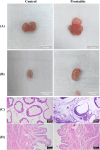Enhancement sensitivity of TRPV1 in dorsal root ganglia via the SP-NK-1 pathway contributes to increased bladder organ sensitivity caused by prostatitis
- PMID: 39544909
- PMCID: PMC11560851
- DOI: 10.3389/fnins.2024.1484980
Enhancement sensitivity of TRPV1 in dorsal root ganglia via the SP-NK-1 pathway contributes to increased bladder organ sensitivity caused by prostatitis
Abstract
Chronic prostatitis/chronic pelvic pain syndrome is a prevalent condition affecting the male urinary system. The urinary dysfunction resulting from this disorder has a direct or indirect impact on the patient's quality of life. Recent studies have suggested that organ cross-sensitization between the prostate and bladder may elucidate this phenomenon; however, the specific molecular mechanisms remain unclear. In this study, we simulated the urinary symptoms of prostatitis patients using an animal model and examined the expression of relevant proteins within the prostate-bladder sensitized neural pathway. We found that transient receptor potential vanilloid 1 (TRPV1) protein is highly expressed in the dorsal root ganglia (DRG) that co-innervate both the prostate and bladder, potentially increasing the sensitivity of TRPV1 channels via the substance P-neurokinin 1 (SP-NK-1) pathway, which may exacerbate micturition symptoms. Furthermore, in the absence of bladder inflammation, elevated levels of neurogenic substances in bladder tissue were found to sensitize bladder sensory afferents. Collectively, these results underscore the significant role of TRPV1 in bladder sensitization associated with prostatitis, suggesting that the inhibition of TRPV1 along this sensitization pathway could be a promising approach to treating urinary dysfunction linked to prostatitis in the future.
Keywords: SP-NK-1 pathway; cross-organ sensitization; prostatitis; transient receptor potential vanilloid 1; urination disorder.
Copyright © 2024 Jiang, Luo, Liu and Long.
Conflict of interest statement
The authors declare that the research was conducted in the absence of any commercial or financial relationships that could be construed as a potential conflict of interest.
Figures





Similar articles
-
Targeting TRPV1 channels in desensitized neural afferent pathways may help mitigate pain and lower urinary tract symptoms caused by prostatitis.Front Pharmacol. 2025 Feb 25;16:1541684. doi: 10.3389/fphar.2025.1541684. eCollection 2025. Front Pharmacol. 2025. PMID: 40070569 Free PMC article.
-
Upregulation of TRPV1 in spinal dorsal root ganglion by activating NGF-TrkA pathway contributes to pelvic organ cross-sensitisation in rats with experimental autoimmune prostatitis.Andrologia. 2019 Sep;51(8):e13302. doi: 10.1111/and.13302. Epub 2019 May 10. Andrologia. 2019. PMID: 31074030
-
Chronic Prostatitis Induces Bladder Hypersensitivity and Sensitizes Bladder Afferents in the Mouse.J Urol. 2016 Sep;196(3):892-901. doi: 10.1016/j.juro.2016.03.077. Epub 2016 Mar 17. J Urol. 2016. PMID: 26997315 Free PMC article.
-
The role of TRPV1 in chronic prostatitis: a review.Front Pharmacol. 2024 Sep 19;15:1459683. doi: 10.3389/fphar.2024.1459683. eCollection 2024. Front Pharmacol. 2024. PMID: 39364048 Free PMC article. Review.
-
TRPV1 in Dorsal Root Ganglion Contributed to Chronic Pancreatitis Pain.J Pain Palliat Care Pharmacother. 2025 May 15:1-9. doi: 10.1080/15360288.2025.2500984. Online ahead of print. J Pain Palliat Care Pharmacother. 2025. PMID: 40371900 Review.
Cited by
-
Targeting TRPV1 channels in desensitized neural afferent pathways may help mitigate pain and lower urinary tract symptoms caused by prostatitis.Front Pharmacol. 2025 Feb 25;16:1541684. doi: 10.3389/fphar.2025.1541684. eCollection 2025. Front Pharmacol. 2025. PMID: 40070569 Free PMC article.
References
-
- Asfaw T., Hypolite J., Northington G., Arya L., Wein A., Malykhina A. (2011). Acute colonic inflammation triggers detrusor instability via activation of TRPV1 receptors in a rat model of pelvic organ cross-sensitization. Am. J. Physiol. Regul. Integr. Comp. Physiol. 300 R1392–R1400. 10.1152/ajpregu.00804.2010 - DOI - PMC - PubMed
LinkOut - more resources
Full Text Sources

